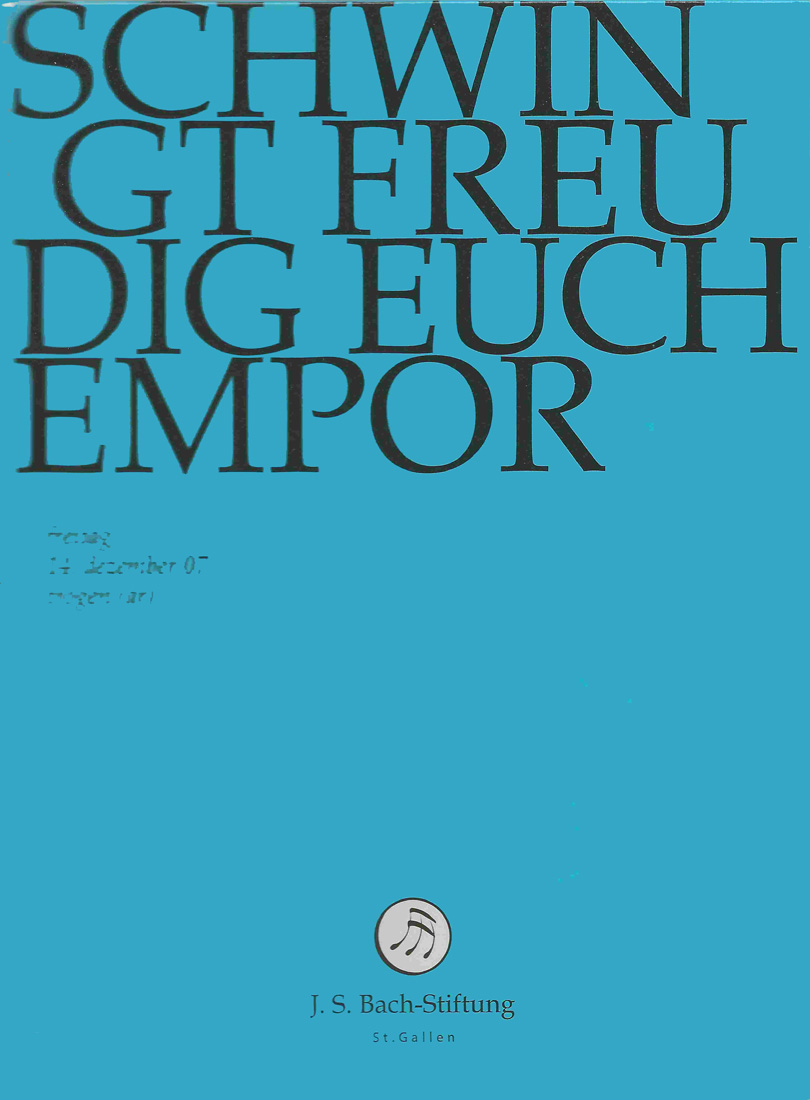Johann Sebastian Bach
Cantata BWV 36, “Schwingt freudig euch empor“
Media Review / Comparison
2012-08-11 — Original posting (on Blogger)
2013-08-01 — New standard layout applied
2014-11-03 — Re-posting as is (WordPress)
2016-06-28 — Brushed up for better readability
Table of Contents
The Media
Ton Koopman, The Amsterdam Baroque Orchestra & Choir
Johann Sebastian Bach: Complete Cantatas, Vol.18
(Cantatas BWV 36, 45, 47, 52, 55, 98, 137, 151, 157, 164, 187)
Ton Koopman, The Amsterdam Baroque Orchestra & Choir
Antoine Marchand / Challenge Classics CC72218 (3 CDs, stereo); ℗ / © 2005

Rudolf Lutz, J.S.Bach-Stiftung St.Gallen
Johann Sebastian Bach: Cantata “Schwingt freudig euch empor”, BWV 36
Rudolf Lutz, J.S.Bach-Stiftung St.Gallen (live recording)
J.S.Bach-Stiftung DVD A370 (DVD, stereo 2.0); © 2008

The DVD above is my third sample from the Cantata recordings by Rudolf Lutz and the J.S.Bach-Stiftung St.Gallen, see my Blog entry “Bach, Cantata BWV 140” for more / general comments. I’m comparing this with Ton Koopman’s recording, included in volume 18 from his complete cantata series.
The last version of this cantata was written for December 2nd, 1731 in Leipzig (First Sunday in Advent).
Ton Koopman, Amsterdam Baroque Orchestra & Choir
As with all other cantatas in his complete edition,Ton Koopman is conducting the Amsterdam Baroque Orchestra & Choir, the vocal soloists are Sandrine Piau (soprano), Bogna Bartosz (soprano), James Gilchrist (tenor), and Klaus Mertens (bass); solo violin: Margaret Faultless. The choir has 19 members (6+4+5+4), string section: 14 (5+4+2+2+1).
The cantata BWV 36 was recorded in 2002.
Part I
- Choir “Schwingt freudig euch empor”
The choir is good & clear, good diction; sometimes, the interpretation sounds a bit “ex cathedra” (accents / phrasing); the oboes sometimes deserve a tad more focus (microphone placement? covered by the bigger choir?)
4:01 — rating: **** - Corale (soprano, alto) “Nun komm, der Heiden Heiland”
The continuo is down with organ (probably single stop) and cello only — makes the piece a bit dry for a festive cantata like this one; the two voices are well balanced and clear
4:01 — rating: *** - Aria (tenor) “Die Liebe zieht mit sanften Schritten”
A rich continuo (organ, lute, cello, bassoon, double bass), and a light, agile tenor voice (James Gilchrist)
5:28 — rating: **** - Corale “Zwingt die Saiten in Cythara”
Carefully phrased and articulated, but lacking almost all interpretation of the text, static, virtually the same expression for all three verses
1:11 — rating: ***
Part II
- Aria (bass) “Willkommen werter Schatz”
The tempo (in my opinion) is a bit too fast: the character per se is OK, but the articulation (especially in the orchestra, ) is suffering, is getting a bit superficial
3:36 — rating: *** - Corale “Der du bist dem Vater gleich”
Compared to Lutz’ interpretation, the two oboes are slightly more distant / less present — probably in order to give the lute in the continuo a chance to heard?
1:44 — rating: **** - Aria (soprano) “Auch mit gedämpften, schwachen Stimmen”
Compared to Lutz / Rial, the tempo is relatively fast, appears to be pushing forward most of the time, and the soprano (Sandrine Piau) often sounds breathless, her vibrato is fairly (too) strong. The articulation is clear, but the movement lacks emotionality (certainly compared to Lutz / Rial!). The violin is supposed to be con sordino (certainly would match the text!) — not sure this is done here.
6:55 — rating: *** - Corale “Lob sei Gott dem Vater ‘ton”
Good articulation and diction, though the phrasing is a bit static.
0:34 — rating: ****
Overall rating
3.5 / 5 (8 tracks)
Rudolf Lutz, J.S.Bach-Stiftung St.Gallen
On the DVD produced by the J.S. Bach Foundation St.Gallen, Rudolf Lutz is conducting the orchestra “schola seconda pratica“, and the “vokalensemble der schola seconda pratica“. He is assisted by the soloists Nuria Rial (soprano), Claude Eichenberger (alto), Johannes Kaleschke (tenor), and Klaus Häger (bass); solo violin: John Holloway. The choir has 12 members (3+3+3+3), string section: 10 (3+3+2+1+1).
This is a live recording from a concert given on December 14th, 2007.
Part I
- Choir “Schwingt freudig euch empor”
Warm acoustics overall — excellent interpretation, warm, soft sound of the two oboe d’amore. From the recording technique, the choir would deserve a bit more clarity — but this is a very minor point, and more than compensated by the “al fresco” aspect of a live recording.
3:57 — rating: ***** - Corale (soprano, alto) “Nun komm, der Heiden Heiland”
The continuo uses more organ stops (?) and adds a double bass — the result is a fuller, warm sound; the interpretation overall is much more expressive and lively than Koopman’s; both voices are good, Nuria Rial’s of course is excellent in vivacity and presence; the alto (Claude Eichenberger) isn’t bad at all, but sometimes is in danger of being covered by Nuria Rial’s volume — and by the stronger continuo.
4:07 — rating: **** - Aria (tenor) “Die Liebe zieht mit sanften Schritten”
Here, the continuo is limited to cello and organ (a very nice chamber organ!); the tenor is a very young voice, certainly with less experience and less volume than James Gilchrist in Koopman’s interpretation, lacking some expression, and occasionally a bit short-winded, but a nice voice otherwise. The tempo is slightly slower than Koopman’s — likely to adjust to the character and the abilities of the tenor voice.
6:05 — rating: *** - Corale “Zwingt die Saiten in Cythara”
In almost extreme contrast to Koopman, a very expressive, flowing, intense and differentiated interpretation, very touching — to me, one of the best chorale I have ever heard (even though the sound quality / transparency can’t quite match that of a studio recording): very well done!
1:03 — rating: *****
Part II
- Aria (bass) “Willkommen werter Schatz”
At first, when comparing to Koopman, the tempo appears a bit slow — but once one realizes how much more detail in articulation, phrasing and expression (also for the bass) is possible, the initial impression of a clumsy tempo is forgotten! Klaus Mertens may have a slightly bigger voice than Klaus Häger — but that is irrelevant here!
3:52 — rating: **** - Corale “Der du bist dem Vater gleich”
Excellent sound management (for a live recording): the two oboe d’amore have a very warm sound and are matching the four tenor voices (the soloist is joining the choir here)
1:41 — rating: **** - Aria (soprano) “Auch mit gedämpften, schwachen Stimmen“
Here now comes the aria which caught my attention and made me have a closer look at this series of recordings of Bach cantatas. This is so much better, richer than the interpretation by Koopman / Piau — just simply no comparison, really! The tempo is calm, feels “right”, and allows the soloists to play out detailed articulation, careful phrasing, and a lot more emotions; Nuria Rial‘s voice and articulation are so natural, warm, expressive — and John Holloway (one of the world’s experts on the baroque violin!) is an ideal partner for this piece, carefully tuning his phrasing and articulation to Rial’s — it’s hard to imagine a better interpretation that this one!
8:12 — rating: ***** - Corale “Lob sei Gott dem Vater ‘ton”
This may be slightly less transparent than Koopman’s interpretation — but there’s more live, and they appear to have more focus on the text / content, the phrasing is less static, the sound warmer.
0:32 — rating: *****
Overall rating
4.4 / 5 (8 tracks)
Conclusion:
Again, the interpretation by Rudolf Lutz and the J.S. Bach Foundation St.Gallen is my clear favorite, as already in Cantata BWV 140 and Cantata BWV 18.





